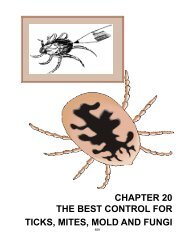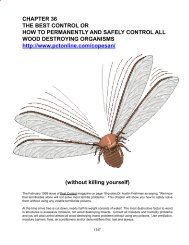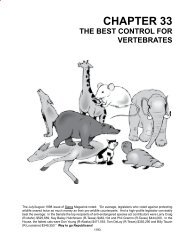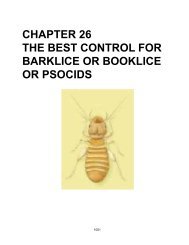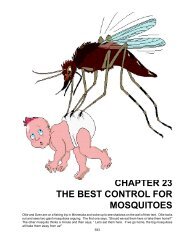chapter 16 the best control for human lice and scabies
chapter 16 the best control for human lice and scabies
chapter 16 the best control for human lice and scabies
Create successful ePaper yourself
Turn your PDF publications into a flip-book with our unique Google optimized e-Paper software.
of head <strong>lice</strong> declines dramatically. Even if <strong>the</strong>y cry, thoroughly <strong>and</strong> routinely wash <strong>the</strong> children’s<br />
heads with diluted peppermint soap, soap with anise oil, neem soap, salt water with vinegar,<br />
natural soap or Lice R Gone ® Shampoos. Be careful to keep all such materials out of <strong>the</strong> eyes!<br />
Safety is <strong>the</strong> most important factor in your choice of <strong>lice</strong> removal techniques because <strong>the</strong> infestation<br />
does not present a real (USA) health risk to <strong>the</strong> host. Pediculicides are all classified as neurotoxin<br />
agents (nerve gas). There are no pediculicide poisons in <strong>the</strong> Lice R Gone ® Shampoo <strong>and</strong>/or Safe Solutions,<br />
Inc. enzyme products.<br />
Caution: 90% of all commercial soap shampoos use a detergent called sodium dodecylsulfate (SDS) or sodium<br />
laureth sulfate (SLES) <strong>and</strong>/or sodium laurel sulfate (SLS) that can be retained in tissues up to 5 days even after<br />
a single drop. Dr. Keith Green noted (SLS) causes improper eye development in children. SLS has a tendency<br />
to react with o<strong>the</strong>r ingredients to <strong>for</strong>m NDELA, a nitrosamine <strong>and</strong> potent carcinogen. Researchers actually<br />
estimate <strong>the</strong> nitrate absorption of one soap shampoo is equal to eating a pound of bacon! The FDA has recently<br />
warned shampoo manufacturers of unacceptable levels of dioxin in products containing SLES. SLS may be a<br />
skin irritant that can penetrate <strong>and</strong> impair <strong>the</strong> skin barrier.<br />
Remember, decisions on <strong>the</strong> <strong>for</strong>mulation/use of dangerous lousicide, treatment of head infections from extensive<br />
infestations, <strong>and</strong> so <strong>for</strong>th, are decisions that still should be made by parents <strong>and</strong> physicians. If you suspect a<br />
personal infestation, first try Lice R Gone ® , Prell <strong>and</strong>/or salt water with vinegar be<strong>for</strong>e going to <strong>the</strong> doctor. All<br />
reported louse infestations of adolescents <strong>and</strong> adults should <strong>the</strong>n be investigated by a physician; if live <strong>lice</strong> are<br />
not seen, <strong>the</strong> nits (if any) should be examined through a microscope to verify that <strong>the</strong>y are not symptoms of o<strong>the</strong>r<br />
scalp conditions. Spend most of your time vacuuming <strong>and</strong> working on <strong>the</strong> infested person - not on cleaning or<br />
spraying <strong>the</strong> area with toxic poisons. If you clean, thoroughly vacuum <strong>and</strong> <strong>the</strong>n use diluted enzyme cleaners or<br />
diluted peppermint soap. We do not recommend any volatile pesticide poisons. Caution: when <strong>the</strong> “normal”<br />
poison treatments don’t work, some physicians prescribe stronger doses of permethrin, a syn<strong>the</strong>tic<br />
pyrethroid, a 5% solution ra<strong>the</strong>r than <strong>the</strong> 1% in Nix ® . But, if <strong>lice</strong> become resistant to <strong>the</strong> weaker solution,<br />
it is likely <strong>the</strong>y will also resist <strong>the</strong> stronger dose (eventually) as well...<strong>and</strong> remember...<strong>the</strong> warning on <strong>the</strong><br />
box of Rid ® <strong>and</strong>/or Brite-Life ® regarding “<strong>the</strong>ir” syn<strong>the</strong>tic pyrethroid, “Not <strong>for</strong> use on <strong>human</strong>s or animals!”<br />
Some over-<strong>the</strong>-counter poison shampoos warn you not to put <strong>the</strong>se poisons on scalps that have been cut or<br />
scratched, yet virtually everyone scratches <strong>the</strong>ir head when <strong>the</strong>y are infested with head <strong>lice</strong>. If you want some<br />
interesting reading, read <strong>the</strong> MSDS <strong>for</strong> all of <strong>the</strong> unregistered, untested “inerts” in <strong>the</strong>se poisons.<br />
BODY LICE<br />
Pediculus <strong>human</strong>is var corporis<br />
Appearance - The body louse is very similar to <strong>the</strong> head louse; <strong>the</strong><br />
body louse is usually 10% - 20% larger, has thinner antennae, not<br />
as deep abdominal indentations, with better developed abdominal<br />
muscles than <strong>the</strong> head louse.<br />
Life Cycle<br />
Egg - This again is generally similar to that of <strong>the</strong> head louse. The<br />
eggs are glued to fibers of clothing <strong>and</strong> are sometimes found stuck<br />
to body hairs. Most eggs are usually found in <strong>the</strong> seams of clo<strong>the</strong>s<br />
which come in contact with <strong>the</strong> skin where <strong>the</strong> adults <strong>and</strong> <strong>the</strong> nymphal<br />
stages are to be found. The body louse lays about twice as many<br />
eggs as <strong>the</strong> head louse <strong>and</strong> <strong>the</strong> nits can remain dormant <strong>for</strong> a period<br />
up to 30 days.<br />
Nymphs - Body louse nymphs spend <strong>the</strong> greater part of <strong>the</strong>ir time in <strong>the</strong> clothing, <strong>and</strong> feeding on <strong>the</strong> host only<br />
takes place when <strong>the</strong> host is resting or sleeping. All stages of <strong>the</strong> body louse congregate toge<strong>the</strong>r, being attracted<br />
to each o<strong>the</strong>r by smell, e.g., <strong>the</strong> odor of <strong>the</strong> excrement. Body <strong>lice</strong> crawl about <strong>the</strong> clothing, generally keeping<br />
close to <strong>the</strong> host’s body, although in heavy infestations <strong>the</strong>y may be seen crawling outside on <strong>the</strong> outer garments.<br />
Length of life cycle - The body louse adults live about twice as long as head <strong>lice</strong>, are more resistant to starvation<br />
<strong>and</strong> exhibit less mortality during development.<br />
794



